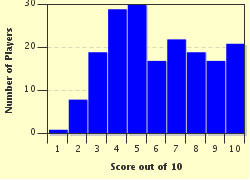Quiz Answer Key and Fun Facts
1. In the central nervous system (brain and spinal cord) there are more neurons than there are glial cells.
2. What is the resting potential of a neuron?
3. The birth and development of new neural tissue is the basis of which neurological concept?
4. Which lobe of the brain is primarily responsible for our ability to see?
5. What is the name of the neurologist that mapped the brain into 52 different areas according to their cytoarchitectonic (histological) characteristics?
6. The thalamus and the hypothalamus are parts of the diencephalon in the brain.
7. A cerebral vascular accident is also known as what?
8. What is the basic sampling unit of an fMRI imaging study?
9. What is the name of the electric charge that propagates down the axon of a neuron and onto other neurons when the cell depolarizes enough to reach its "threshold"?
10. Which of the following is not considered a part of the limbic system?
Source: Author
schuhmacher
This quiz was reviewed by FunTrivia editor
crisw before going online.
Any errors found in FunTrivia content are routinely corrected through our feedback system.


